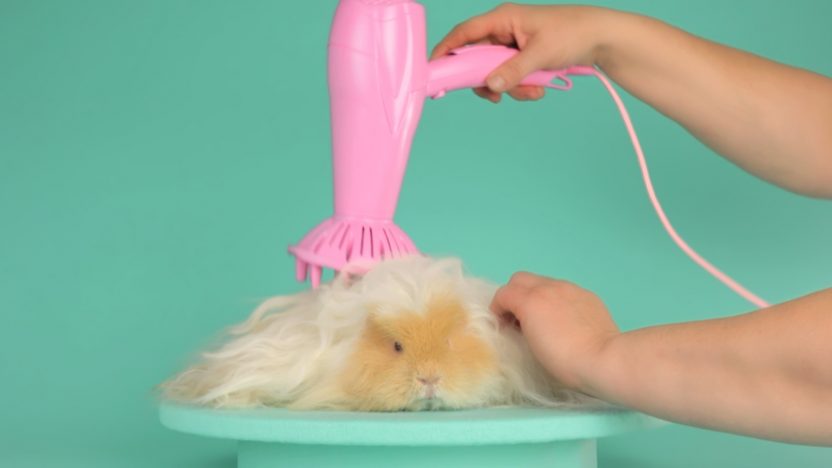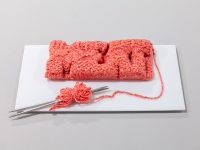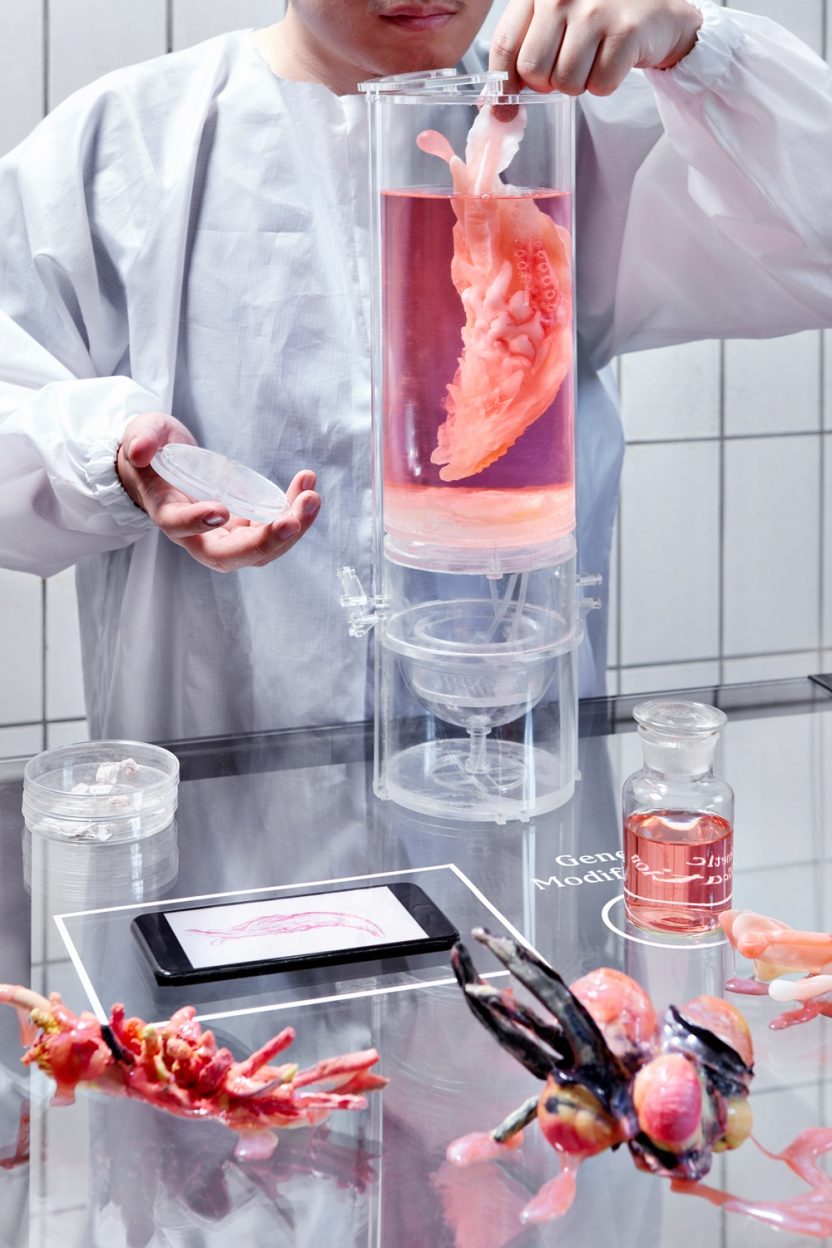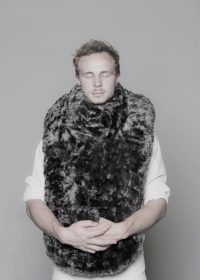
Creatures Made to Measure
Animals and Contemporary Design
Cattle in enclosed spaces or lab-grown meat? Stroking a cuddly pet or a robot? The relationship between man and animal is highly complex and fraught with contradiction. On the one hand pets are pampered and we have an idealised image of the animal world. On the other hand animals are often treated inhumanely out of sight in slaughterhouses, laboratories or during transport. Starting on 17 May, Creatures Made to Measure strives to find the right balance between affection, respect and benefit. An exhibition as part of the design and society programme, in which Design Museum Gent wants to encourage us to reflect on the man-animal future relationship.
Early cave paintings already demonstrated man’s fascination with the animal world. However, we have also always felt a strong desire to use animals for our own benefit: what started with their meat and hides soon developed into using them in fighting rings, zoos and on the battlefield. We now consider it quite normal that animals are used as test objects in medical laboratories, participate in beauty contests and keep us company. But what if we go even further in manipulating animals so that they serve as organ donors or are artificially bred in laboratories? Can we still talk about ‘animals’ then? The huge discrepancy between the discussions on how we should deal with animals and the changes that are actually taking place, underlines how difficult it is for us to redefine the relationship between man and animal.
This area of conflict offers designers various starting points. In the three chapters of Creatures Made to Measure, designers ask questions as to the acceptable degree of manipulation and present several future perspectives on the relationship between humans and animals.
Are humans superior to animals?
Are you an animal?
Is your best friend your pet?
Groomed guinea pigs

Companions and Counterparts looks at animals in our living rooms. The pet industry is booming with services including birthday gifts, wellness farms and cosmetic surgery. Irrespective of the way they behave naturally, animals become toys and projection surfaces for human needs. For example, in her video clip Golden Boy, Thalia de Jong shows off the eponymous prize-winning guinea pig, which is being groomed on a presentation stand. The mirror installation entitled Architecture for Dogs: Paramount by designer Konstantin Grcic offers a perfect platform for poodles – despite the fact that dogs are unable to recognise their own reflection. On the other hand, many people yearn for a return to nature and animal values. For example, in GoatMan. A Holiday from Being Human the British designer Thomas Thwaites spends a few days pretending to be a goat in the Swiss Alps in order to release himself from all human constraints such as his constant quest for progress and to reflect on his own actions.
Why do we eat cows but not dogs?
Would you eat lab-grown meat?
Are there any wild animals left?
Meat from a Petri dish
The second chapter, Resources and Substitutes, looks at how we treat animals as a source of raw materials. Almost all products include substances of animal origin. The fact that animals appear to be indispensable is increasingly resulting in ethical, ecological and economic conflict. Theo Deutinger, for example, illustrates everyday instances of cruelty in his Handbook of Tyranny. Among other things, he interprets the expertise of zoologist Temple Grandin in detailed infographics. Her slaughterhouse design with oscillating noise-reducing walls gives cattle greater dignity by ensuring that the animals walk ahead in one direction without seeing other dead animals. In response to the mounting controversy about meat, the food industry is trying to replace meat products with vegetarian and vegan alternatives, or even insects and in-vitro meat. Bistro In Vitro is already giving you the option to book a table for 2028 in a restaurant serving lab-grown meat.

Should we be allowed to manipulate animals?
Do you feel responsible for extinct animals?
Do you trust modified animals?
Chickens without feathers

What if you take this even further? The final chapter, Optimisation and Visions of the Future, takes a look at human intervention into the animal world and develops alternative future scenarios. Sensational publications about glowing ornamental fish or featherless chickens may well sound like science fiction, but the research findings are by no means limited to the lab. As demonstrated by the actress Barbra Streisand when she decided to clone her deceased pet dog. Although genetic recoding heralds many positive effects, we must ask whether this brave new world is actually worth aspiring to. For example, do we want to eat meat or eggs from Fool’s Fowl, Pinar Yoldas’ minimal chicken devoid of all superfluous limbs and organs? Or shoes made from the skins of genetically manipulated stingrays from the fictitious start-up Rayfish Footwear by Next Nature Network? Over in China, the huge demand for ingredients from wild animals in traditional Chinese medicine represents a real danger for endangered animal species. The Tiger Penis Project of Kuang-Yi Ku proposes to use new developments in biotechnology to replace animal parts, such as the tiger penis, with artificial ones.
In the research area, developed in conjunction with Ghent University, visitors will be given more information on several current cases, such as Belgian Blue cattle.
This exhibition was created by the museum Marta Herford in collaboration with, and on the basis of a concept by, designer and curator Tanja Seiner. The exhibition in Design Museum Gent has been supplemented with a selection of new objects curated by Evelien Bracke.
Participating designers and artists
Martin Avila, BLESS, Melanie Bonajo, Karin Borghouts, The Center for Genomic Gastronomy, Kurzgesagt - Ina Nutshell, Center for PostNatural History (Richard Pell), Marcus Coates, Thalia de Jong, Theo Deutinger, Aleksandra Domanovié, Konstantin Grcic, The Hercules and Leo Case, Christine Herdin/Katharina Wahl, Marlène Huissoud, Max Kosoric/Sanne Pawelzyk, Silvia Knüppel, Kuang-Yi Ku, Dietrich Luft, Lisa Ma, Christien Meindertsma, Next Nature Network, Thomas Pausz, Ana Rajcevic, Veronica Ranner, Andrea Roe / Cath Keay, Peter Schäfer, Johanna Schmeer, Basse Stittgen, Susana Soares, Sputniko, threeASFOUR, Thomas Thwaites, Koen Vanmechelen, Marije Vogelzang, Chris Woebken, Pinar Yoldas

Catalogue
Price: € 20
Dimensions: 12.4 cm x 19 cm
208 pages
Publisher: Kerber Verlag
Language: Dutch and English
Practical information
Creatures Made to Measure. Animals and Contemporary Design
17.05.2019 – 29.09.2019
Admission: € 8 / € 6 / € 2
Open on weekdays from 9:30 to 17:30
Open at weekends, on public holidays and during school holidays from 10:00 to 18:00
Closed on Wednesdays
Sandra Plasschaert
Cats Communication
Press & PR
+32 479 35 10 39
sandra@catscommunication.be
Simon Adriaensen
Design Museum Gent
Communication
+32 9 323 64 88
simon.adriaensen@stad.gent